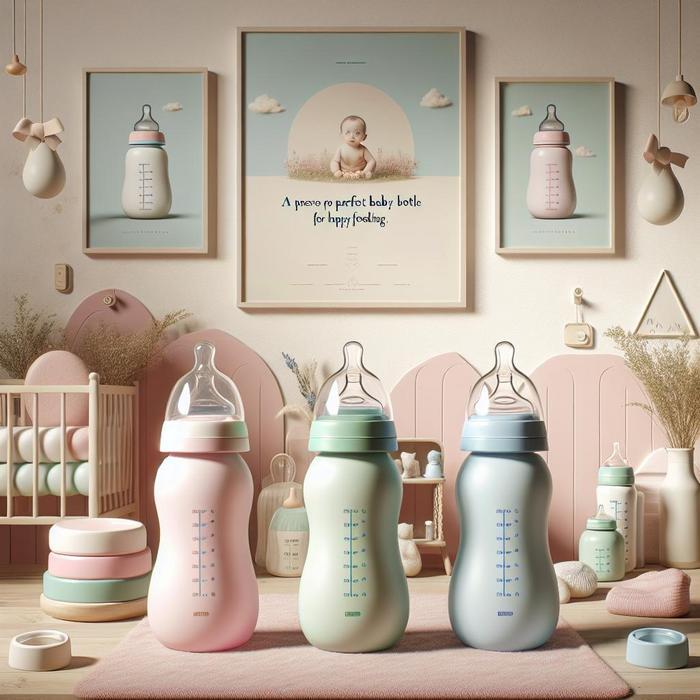The Significance of Choosing the Perfect Bottle for Your Baby
We all want the best for our little ones, especially when it comes to feeding. Choosing the perfect bottle for your baby is an integral part of ensuring a happy, stress-free feeding experience. This is where a great deal of love and patience comes into play. But how do you ensure you’ve found the ‘goldilocks’ bottle that’s just right for your precious one? Let’s explore.
What Makes a Perfect Baby Bottle?
Each baby is different, hence, the “perfect” bottle varies among babies. But there are a few common factors to consider:
- Material: Baby bottles are usually made of plastic, glass, or stainless steel. Each has its pros and cons. Plastic is light and unbreakable, but can wear out over time. Glass is durable and doesn’t absorb odors, but can break. Stainless steel is robust and long-lasting, but usually more expensive.
- Nipple Shape: Some babies prefer a specific nipple shape—orthodontic, flat-topped, or classic dome-shaped. The perfect bottle would have the right nipple shape for your baby.
- Flow Rate: The flow rate should be appropriate for your baby’s age and feeding style. The wrong flow can cause your baby to eat too quickly or struggle to get enough milk.
Ensuring a Smooth Transition to Bottle Feeding
Transitioning from breastfeeding to bottle feeding can be a big adjustment for both mom and baby. For a more seamless transition, you might want to consider slow flow bottles for breastfed babies. This can aid in maintaining the breastfeeding and bottle feeding balance which is key to a positive feeding experience.
For more tips on ensuring a smooth bottle feeding transition, check out
this helpful article.
The Top Contenders: Perfect Bottles for Baby Feeding
While there are many baby feeding essentials out there, finding the top baby bottles that would result in happy feeding times can be quite a quest. To make it easier, here are a few well-loved bottles that have been praised by parents:
- The biomimetic feeding bottle: This replicates the feeding mechanism of breastfeeding, helping the baby maintain a stable feeding rhythm and minimizing discomfort.
- The slow flow bottle: Perfect for breastfed babies, these bottles help them adjust to bottle feeding at their own pace. Discover the best slow flow bottles for breastfed babies here.
- The anti-colic bottle: These bottles feature unique venting systems to prevent your baby from swallowing air during feeding, significantly reducing the occurrence of gas and colic.
On a final note, always remember that feeding is much more than just nourishing your baby. It’s a bonding time, filled with closeness and love. Whatever bottle you choose, be patient and watchful for your baby’s cues. For more insights, you can join the conversation on Reddit and learn from other parents’ experiences.
Balancing Bottle Feeding and Breastfeeding
Transitioning between bottle and breastfeeding can bring forth certain challenges. As each feeding method has its unique rhythm and technique, simultaneously balancing both can confuse the baby, leading to the rejection of one form of feeding. For parents whose babies refuse to take the bottle, a flexible feeding approach, combined with gentle perseverance, can lead to success. Explore how to encourage your breastfed baby to take a bottle here.
Better Bonding with Bottle Feeding
Feeding time, irrespective of the method used, is a mutual bonding experience between the baby and the parent. Bottle feeding in no way diminishes this connection. In fact, it can even strengthen the bond as it allows others, like partners and siblings, to be part of the feeding process, forging their own unique bond with the baby. For more insights on bonding through bottle feeding, visit Healthline.
Importance of A Secure Attachment
A stable, secure attachment between babies and their caregivers is crucial for the baby’s development. Good feeding habits lay the foundation for a secure attachment. Bottle feeding can play an essential role in achieving this, by allowing the baby to interact closely with the caregiver. Discover more about secure attachment and its significance here.
Feeding A Newborn: A Comprehensive Guide
Feeding a newborn can be tricky, especially for first-time parents. Figuring out how often, how much, and understanding feeding signs can be overwhelming. When offering a bottle, clues indicating the baby is full or needs more can be harder to pick up. As a comprehensive guide on feeding your newborn, click here.
Investing in a Quality Bottle
A high-quality feeding bottle is always a worthy investment. It assures safety by being BPA-free and reduces fussiness, ensuring a smooth feeding journey. From a long-term viewpoint, good quality bottles retain their condition for longer periods, proving their durability and effectiveness. More importantly, the right bottle can play a crucial role in your baby’s growth and development.
Bottle Cleaning and Sterilization
Ensuring your baby’s bottles are clean and sterilized is a critical aspect of bottle feeding. Dirty bottles can harbor harmful bacteria that could make your baby sick. Cleaning the bottle after every use minimizes this risk, and sterilizing it before each use adds an extra layer of protection for your baby. Remember, sterilizing goes beyond cleaning- it kills bacteria that simply washing with soap and water cannot eliminate.
Embracing bottle feeding as an option opens up new possibilities in your baby’s feeding journey. It allows others to be involved in feeding, helps manage feeding better when you’re not around, and creates room for flexibility. Be open to exploration, be patient, and remember- every baby is unique in their preference. In the world of baby feeding, what works best for one, may not work for another.

